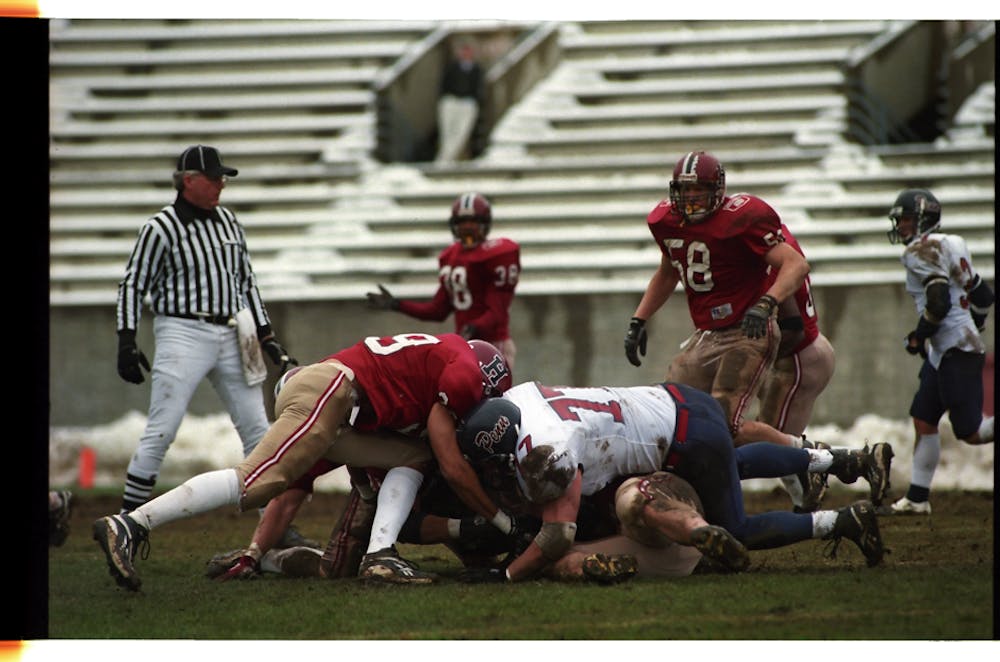
After one of its most violent weekends in recent memory, the National Football League is taking action to curb contact that could cause dangerous head injuries.
The League announced Tuesday that it would begin suspending players for flagrant hits that previously were penalized by fines, with special scrutiny involving helmet-to-helmet tackles.
The penalties will set a precedent for how leagues can take action regarding excessive hits and could be key in preventing injuries that result from dangerous play, even for younger athletes.
The decision comes after at least six NFL players exited games this week with head injuries. At the collegiate level, Rutgers defensive tackle Eric LeGrand was paralyzed from the neck down after a hit against Army Saturday.
“I think everything really starts from the highest level, which would be the NFL and the commissioners offices, and works all the way down,” Penn football coach Al Bagnoli said Tuesday. “And I think it certainly goes through colleges and will permeate through high schools.”
Bagnoli, whose Quakers experienced the aftermath of head injury first hand when former player Owen Thomas committed suicide last April and was found to have a brain disease linked to head trauma, said there is a greater awareness of the severity and complexity of head injuries among players now.
“It’s something that everybody should certainly track and follow,” Bagnoli added.
While the coach said the NFL’s policy should have a trickle-down effect on college and high school players, Chris Nowinski, president of the Sports Legacy Institute at Boston University, is focused on also solving the issue from the youngest players up. Nowinski and researchers at the institute completed the study that found signs of a neuro-degenerative disease in Thomas’ brain.
A three-time letterwinner on the Harvard football team, Nowinski went into professional wrestling out of the Ivy League under the pseudonym “Chris Harvard.” His wrestling career ended after a 2003 concussion. Since then he has turned his attention to solving issues of head trauma in sports. Nowinski co-founded the Institute in 2007.
“I’m hopeful that in 2010 the athletes in the Ivy League locker rooms now know about concussions, know about the long-term risks of brain trauma and are making informed decisions and are choosing to seek out their athletic trainer when they have a concussion, rather than never thinking twice about it,” he said.
Ivy League Director Robin Harris said that she’s heard anecdotally of student-athletes reporting concussions at a more frequent rate this fall.
“I think that’s a much more positive outcome,” Harris said. “Student-athletes need to realize this is serious and they need to report it and get treatment. If that means missing part of a game or all of a game or multiple games, then so be it.”
Nowinski sees comprehensive education on concussion and brain trauma as an immediate solution. He said he’d like to see all college athletes and coaches required to participate in an established education program by next year.
“The Ivy League has the best opportunity to be progressive in terms of regulating brain trauma — how many days or weeks you can hit,” he said.
“The technology is there to put sensors in everyone’s helmets, whether it’s football, hockey or lacrosse, and measure how many times they’re getting hit in the head and start setting actual standards. I think that’s the direction this whole shift is moving.”
He pointed to pitch count limits protecting arms in both professional and youth baseball as a parallel to controlling the amount and frequency of head impacts in football players.
“We’ve never even thought about it with the brain, which is far, far more important to their life.”
Recent studies have shown the high-school players can get hit in the head almost 2000 times a year — 75 percent of those hits come from practice, Nowinski said.
“That number is simply too high,” he added.
“We’re trying develop ways and inspire coaches to recreate practice to not involve brain trauma.”
The Daily Pennsylvanian is an independent, student-run newspaper. Please consider making a donation to support the coverage that shapes the University. Your generosity ensures a future of strong journalism at Penn.
DonatePlease note All comments are eligible for publication in The Daily Pennsylvanian.




